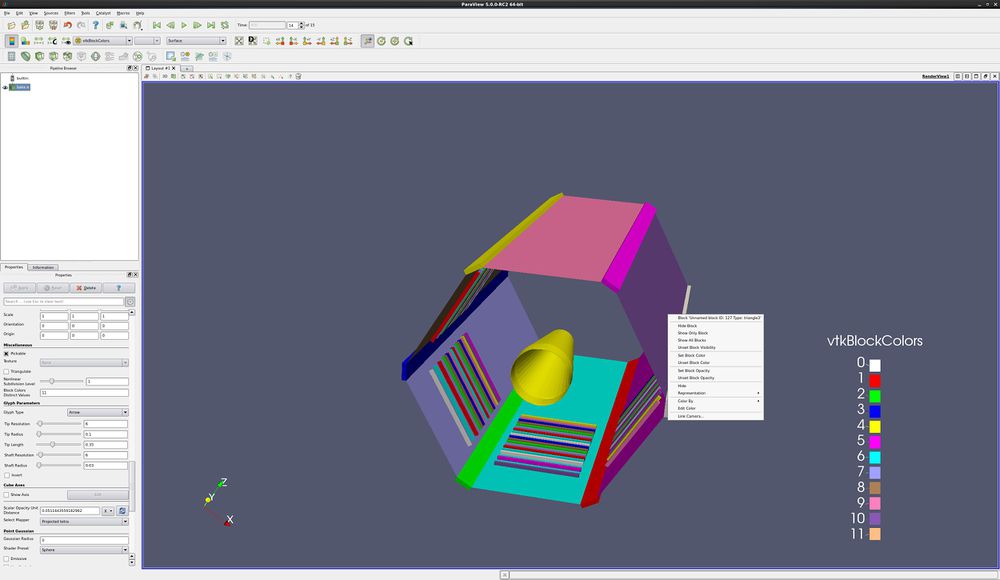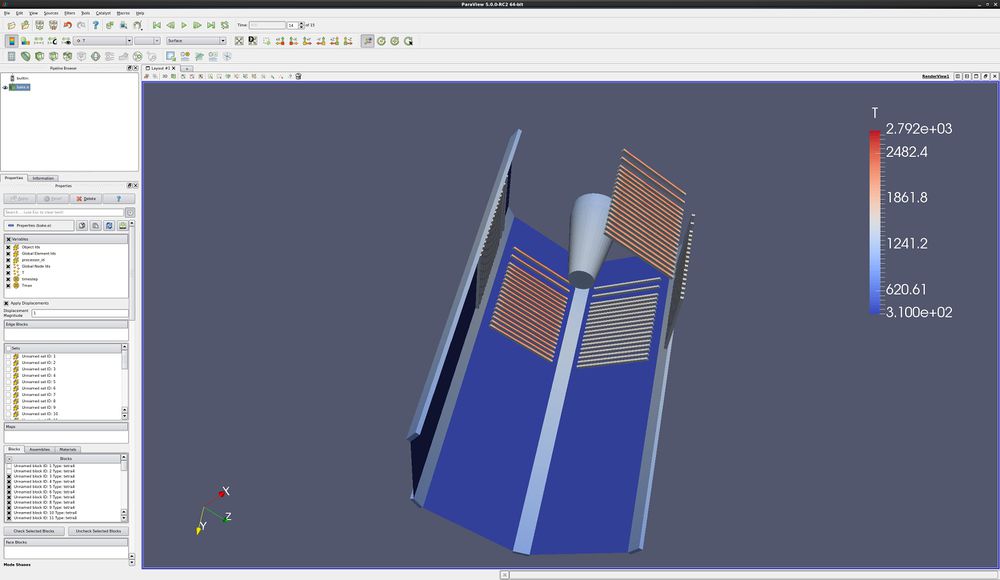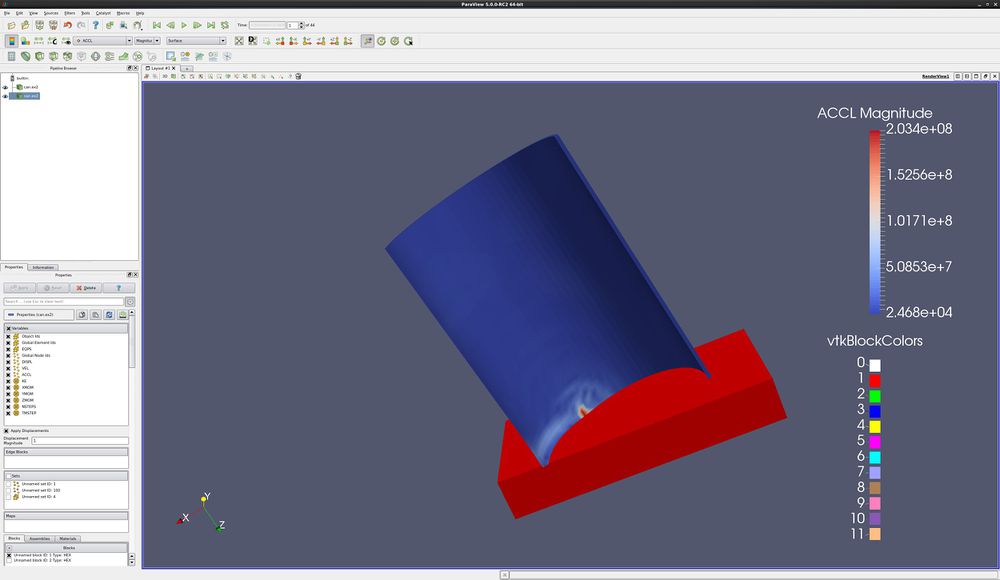|
|
| Line 1: |
Line 1: |
| =Introduction= | | =Introduction= |
| This tutorial covers multiblock processing and data analysis. | | This tutorial covers multiblock processing and data analysis. It also uses the dataset bake.e, which can be found in the ParaView Data downloads from paraview.org. |
|
| |
|
| ==Multiblock - Color two blocks differently== | | ==Block commands onscreen menu== |
| *Color two blocks differently
| | Bake.e is a dataset that simulates the heating of a cone in a test facility. It has numerous blocks. T (for temperature) is the primary variable of interest. |
| *Open the dataset can.exo. Turn on all variables. Apply. | | *Open the dataset bake.exo. Turn on all variables. Apply. Your dataset is now colored by block. |
| *Block 0
| | *Change vtkBlockColors to T. Your dataset is now colored by temperature. Play forward in time, and look into the simulation. Be sure to rescale to data range. |
| **Be sure that can.exo is selected in the Pipeline Browser.
| | *Change color back to vtkBlockColors. |
| **Filters/ Alphabetical/ Extract Block. | |
| **Select Dataset 0.
| |
| **Color by ACCL
| |
| *Block 1
| |
| **Be sure that can.exo is selected in the Pipeline Browser.
| |
| **Filters/ Alphabetical/ Extract Block.
| |
| **Select Dataset 1.
| |
| **Color by Displ
| |
| *Go to the last frame.
| |
| *Select ExtractBlock1 in the Pipeline Browser.
| |
| *Rescale to dataRange
| |
| *Select ExtractBlock2 in the Pipeline Browser.
| |
| *Rescale to dataRange | |
| *Go to the first frame, then Animate.
| |
| *Do NOT delete this state - we will use it for the next section.
| |
|
| |
|
|
| |
|
| | Notice that this model has 6 sides, and there are 12 annotation colors. Thus, they repeat. Lets make them random. |
|
| |
|
| [[Image:advanced_multiblock_1.png|800px]]
| | *Properties tab, Advanced. Slide down towards the bottom, and find '''Block Colors Distinct Values'''. Change this to '''11'''. |
|
| |
|
| |
|
| ==Multiblock – Automate Rescale==
| | *Right click on a side (a block). Notice that the bock name and ID are shown. |
| It is possible to change how ParaView rescales the minimum and maximum values for a variable. The default behavior is designed for large or very large data. For other datasets, you can either have ParaView open the dataset in the last timestep, or "grow" the minimum and maximum to fit all timesteps.
| | *Right click on a side. Change the block's color and opacity. |
| | *Right click on a side. Hide, then unhide the block. |
|
| |
|
| The following steps are for the "Grow Every Timestep" option.
| |
| *Go to '''Edit → Settings → General'''
| |
| **Leave '''On File Open''' '''Goto current timestep'''
| |
| **Change '''Rescale Data Range Mode''' to '''Grow every timestep'''. OK.
| |
| **Note - If you want ParaView to open in the last time step, change '''On File Open''' to '''Goto last timestep'''.
| |
|
| |
|
| *'''First Frame'''
| | [[Image:advanced_multiblock_1.png|1000px]] |
| *'''Play'''
| | |
| Lets repeat, and see if the minimum and maximum were set correctly.
| |
| *'''First Frame'''
| |
| *'''Play'''
| |
|
| |
|
| | ==Don't load some blocks== |
| | You can easily change which blocks you load. This is done through selections. Here is an example. |
| | *Open the dataset bake.exo. Turn on all variables. Apply. Your dataset is now colored by block. |
| | *Choose the Select Block icon (or hit the '''b''' key), then rubber band select the blocks on the outside edge of bake. You have selected numerous blocks. |
| | *On the Properties tab, slide down to the section named Blocks. Click '''Uncheck Selected Blocks'''. Click '''Apply'''. |
|
| |
|
|
| |
|
| ==Multiblock – Select a range of blocks - Object Inspector==
| | [[Image:advanced_multiblock_2.png|1000px]] |
| *Edit/ Delete All
| | |
| *Open the dataset bake.exo. Turn on all variables. '''Apply'''.
| |
| *Hold down the control key, and '''Select Block''' for the six outside blocks of bake.
| |
| *In the Object Inspector, click on '''Uncheck Selected Blocks'''.
| |
| *Scroll down the list of blocks in the '''Blocks''' section of the '''Object Inspector'''. Notice that we have turned off '''122, 123, 124, 125, 126''' and '''127'''.
| |
| *'''Apply'''.
| |
| *You can use the same technique to only turn on specific blocks. After selecting the blocks, turn all blocks off, and then'''Check Selected Blocks'''.
| |
| *'''Apply'''.
| |
| *Notice that you can use the <ctrl> and <shift> key to turn on and off groups of blocks directly in the Object Inspector.
| |
|
| |
|
|
| |
|
| [[Image:advanced_multiblock_2.png|800px]]
| | ==Load the same dataset twice== |
| | | *Open the dataset can.exo. Turn all variables on. Only turn on block ID '''2'''. '''Apply'''. |
| ==Multiblock – Select objects - Find Data== | | *Open the dataset can.exo. Turn all variables on. Only turn on block ID '''1'''. '''Apply'''. |
| This functionality can be used to select blocks, cells, points, etc.
| | *Change the timestep to 1. |
| *'''Edit'''/ '''Delete All'''
| | *Color by '''ACCL'''. |
| *Open the dataset bake.exo. Turn on all variables. '''Apply'''. | | *Play |
| *'''Edit'''/ '''Find Data'''
| |
| *Select '''Block Id''', "is", and then select the '''...'''. At present, ParaView requires it's internal structure number. Select block 1, then OK. (The number 2 will appear in the window.) | |
| *'''Run Selection Query'''. | |
| *If desired, you can '''Extract Selection''' or '''Plot Selection Over Time''' (only on single points or cells).. | |
| | |
|
| |
|
| ==Data Analysis - Point Labels==
| | [[Image:advanced_multiblock_3.png|1000px]] |
|
| |
|
| *Open the data set can.exo.
| |
| *Change the Style Representation to Surface With Edges.
| |
| *On the toolbar, push the Select Points On icon. This will allow you to manually select a point on your data set and have the id of those points displayed.
| |
| *Rubber band select a point (node)
| |
| *From the View menu select the menu option Selection Inspector.
| |
| *Notice that all of the point indexes are listed.
| |
| *On the Selection Inpector panel, scroll down to the bottom and click on the Point Label tab. Check the Visible check box. This will display the point IDs on the data set.
| |
| *You can also do a lookup in the opposite direction.
| |
| *On the Selection Inspector panel, scroll to the top and enter an Index Range or Global ID Range number. On can.exo, an example is Composite ID 2 (first generic block), and point 100. It will display on your dataset.
| |
| *Try toggling the Select Cells that Include the Selected Point on.
| |
| *HINT – change to wireframe to find the points or cells you have selected.
| |
| *Extra Credit – Try the same selection steps with cell type data. For a cell number, try Composite ID 2, cell 100.
| |
|
| |
|
| |
| [[Image:advanced_multiblock_3.png|800px]]
| |
|
| |
| | | |
| ==Data Analysis - Spreadsheet and histogram view==
| |
| *Open Can.exo.
| |
| *Highlight the can window, and '''Select Cell''' on the can.
| |
| *'''Split Horizontal'''
| |
| *'''Split Vertical'''
| |
| *In the upper right window, select '''Spreadsheet View'''.
| |
| *Change the '''Attributes''' to '''Cell Data'''. Return it to '''Point Data'''.
| |
| *Select the '''Show Only Selected Elements''' check box (next to Precision).
| |
| *'''Note that the Spreadsheet can now be sorted - including in parallel.'''
| |
| *Select a different cell on the can.
| |
| *Highlight the lower right window.
| |
| *'''Filters'''→'''Data Analysis'''→'''Histogram'''. '''Apply'''.
| |
| *Change Scalars to DISPL. Apply.
| |
| *Animate forward in time one step at a time.
| |
| *Play
| |
|
| |
|
| |
| [[Image:advanced_multiblock_4.png|800px]]
| |
|
| |
| ==Data Analysis - Advanced Spreadsheets ==
| |
| *You can either display all of your dataset's points or cells in your spreadsheet, or only those that are selected in the 3d view. With the '''spreadsheet''' window selected, on the '''Display''' tab, click '''Show only selected elements'''.
| |
| *When cells or points are selected in the 3d window, the appropriate row(s) in the spreadsheet view will be highlighted.
| |
| *Highlighting works both ways - if you select a row or rows in the spreadsheet view, the cell or point on your dataset will be selected.
| |
| *You can select multiple rows in the spreadsheet by holding down the '''<ctrl>''' key, and can select ranges of rows by holding down the '''<shft>''' key.
| |
| *'''Note that the Spreadsheet can now be sorted - including in parallel.'''
| |
|
| |
|
| |
| ==Data Analysis - Frustrum ==
| |
| *When you are using the '''Select Cells Through''' or '''Select Points Through''', it is possible to see the frustrum (the 3d space you selected). Turn on '''View/ Selection Inspector''' , then '''Selection Type''' - '''Frustrum''', then click the '''Show Frustrum''' check box.
| |
|
| |
|
| |
| ==Data Analysis - Extract Selection==
| |
| *Open can.exo.
| |
| *On the toolbar, push the '''Select Cells On''' icon. This will allow you to manually select a cell on your data set.
| |
| *Click on the can in one location, turning on only one cell.
| |
| *'''Filters→Data Analysis→Extract Selections''', then click the '''Copy Active Selection''' button, and '''Apply'''.
| |
| *Split Vertical, Spreadsheet View, and turn on the eyeball in front of the '''ExtractSelection''' filter.
| |
| *You can see Cell data by selecting the '''ExtractSelection→Display''' tab and changing the '''Select Attributes''' to '''Show'''.
| |
| *Try animating the data.
| |
| *Extra Credit: Turn on visibility of the can, and display it in wireframe. Change the color of the selected cell to Red. (The following picture is including the extra credit.)
| |
|
| |
|
| |
| [[Image:advanced_multiblock_5.png|800px]]
| |
|
| |
|
| |
| ==Data Analysis - Spreadsheet data by time==
| |
| *Open can.exo.
| |
| *On the toolbar, push the '''Select Points On''' icon. This will allow you to manually select a point on your data set.
| |
| *Rubber band select a point, turning on only one point.
| |
| *'''Filters→Data Analysis→Plot Selection Over Time''', then click the '''Copy Active Selection''' button, and '''Apply'''.
| |
| *Split Vertical, Spreadsheet View, and with the Spreadsheet View highlighted, turn on the eyeball in front of the '''PlotSelectionOverTime''' filter.
| |
| *Note that you can then write this data out to a .csv file using '''File''' → '''Export'''.
| |
|
| |
|
| |
|
| [[Image:advanced_multiblock_6.png|800px]]
| |
|
| |
|
| =Acknowledgements= | | =Acknowledgements= |
| Sandia is a multiprogram laboratory operated by Sandia Corporation, a Lockheed Martin Company, for the United States Department of Energy’s National Nuclear Security Administration under contract DE-AC04-94AL85000. | | Sandia is a multiprogram laboratory operated by Sandia Corporation, a Lockheed Martin Company, for the United States Department of Energy’s National Nuclear Security Administration under contract DE-AC04-94AL85000. |


